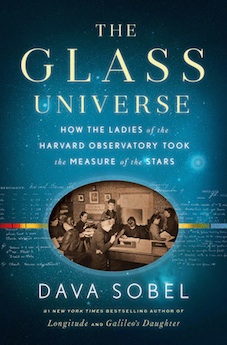By Jay M. Pasachoff
As a teacher of the astronomy survey course, and a textbook author, I know and transmit to my students the fundamental facts and ideas of the astronomy of the stars. The discoveries just over a hundred years ago by the computers at the Harvard Observatory—and “computers” were people then—are celebrated by this book. The computers’ discoveries are at the basis of astronomy even to this day—the temperatures of the stars help reveal their evolution, and the variations of a certain type of star constitute an important part of the cosmic distance ladder.
For these basic astronomical ideas, we have Annie Jump Cannon and Henrietta Leavitt, respectively, to thank. They were two of the most influential of the dozens of women, paid 25¢ per hour then, who examined hundreds of thousands of glass photographic plates—the Glass Universe of the title. Science journalist and author Dava Sobel, whose Longitude became a best seller, uses her narrative and scientific skills to ably and compellingly tell the story of the women and their discoveries. Annie Jump Cannon and Williamina Fleming were even granted rare honorary memberships in the Royal Astronomical Society for their work. One of the computers was even the first woman, as Curator of Astronomical Photographs, to have an official title in Harvard University.
I had long thought that Edward C. Pickering, who was Director of the Harvard Observatory for 42 years, might be a villain for his underpaying the women. But in this telling, he is a hero for respecting the work of the women and for finding the money to pay them at all. Much of Annie Cannon’s work was paid for by Anna Draper, the widow of the talented amateur astronomer Dr. Henry Draper, who was a pioneer in using the newfangled spectroscopy to transform astronomy into astrophysics. And an online inflation calculator tells me that 25¢ in 1910 transforms, at 3.11% per year, to $6.08 in 2016 dollars, half the near-future minimum wage but not that much below some salaries today.
Sobel sets the scene on Observatory Hill in Cambridge, telling us about not only the work but also the lives of these individuals, some with Wellesley degrees and others without. She describes the telescopes in Cambridge, Peru, and South Africa that were used to amass the photographic plates and about the sometimes colorful individuals involved in taking the observations.
At a 2009 celebration of the life and work of Henrietta Leavitt, it was agreed to refer to the so-called Period-Luminosity Relation that she had discovered as “Leavitt’s Law,” in parallel to “Hubble’s Law” for the Velocity-Distance Relation that is key to today’s cosmology and that depended in Leavitt’s work to be established. Leavitt had noticed that for a particular type of variable star in the Magellanic Clouds, satellite galaxies of our own Milky Way Galaxy and therefore each having all its stars at the same distance from us as others: “It is worthy of notice that the brighter variables have the longer periods.”
Would my students understand this breakthrough that led to measuring cosmic distances better if they had read, instead of my own textbook’s plain words, Sobel’s lyrical description: “In the runic line patterns…. Each spectrum’s thousands of Fraunhofer lines registered the leaping of electrons from one energy level to another as they orbited atomic spectra”? Sobel’s felicitous language also yields an explanation of Hubble’s law more sonorous than the plain language of my own text; she writes “the farther the galaxy, the faster it fled.”
The second half of the book carries the story forward, with Henrietta Leavitt and Annie Jump Cannon still on the scene, at least until the former’s passing, and with the arrival of new talent, first long-term director Harlow Shapley and then Cecilia Payne. We arrived at the era that overlaps my own. Though Shapley had retired (and returned only once to the Observatory during my years there), Miss Payne had married an emigré Russian astronomer, and had, in the 1950s, been promoted by Donald Menzel, when he became Shapley’s successor, as professor of astronomy. Little did I know when, as a freshman, I met the formidable (tall, chain-smoking, British accented) Mrs. Payne-Gaposchkin, professor of astronomy and chair[man] of the Astronomy Department, she was the only female professor on Harvard’s Faculty of Arts and Sciences.
Though the bulk of the book is well-told journalistic history of science, Sobel brings us up to date, with the ongoing DASC@H project now underway: “Digital Access to a Sky Century at Harvard.” The first ten years of the project brought us through only scanning about 1/4 of the half million glass plates—the Glass Universe of the title. As she describes, the project is now recovering from the burst water main that flooded the plate stacks’ lower floor, with about 15% of the collection needing to be conserved.
Dava Sobel adds another well-told tale to her series of books about major advances and people in astronomical history, from her best-seller Longitude to her discoveries about Galileo’s daughter and to her recent play about how Copernicus’s magnum opus came to be published.
Astronomer and author Jay M. Pasachoff is the director of the Hopkins Observatory and Field Memorial Professor of Astronomy at Williams College. He is a Visitor in the Planetary Sciences Department of Caltech. Williams College is home to the Gamma of Massachusetts Chapter of Phi Beta Kappa.




